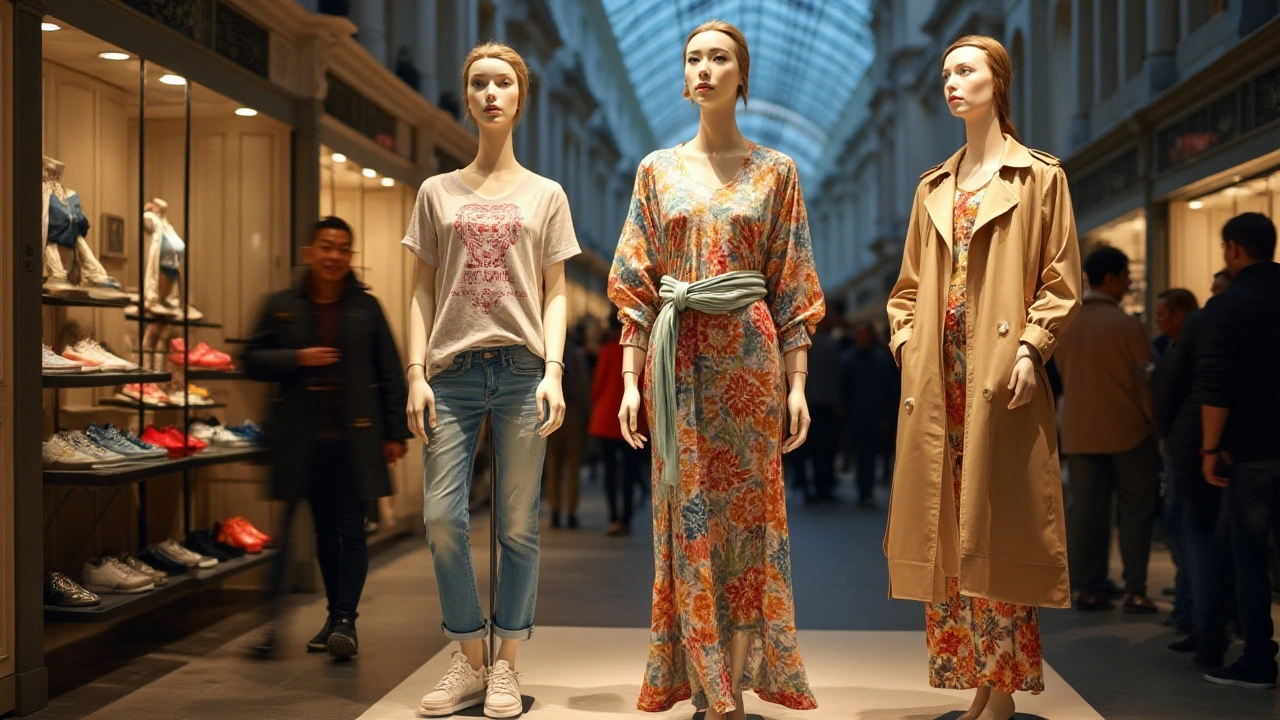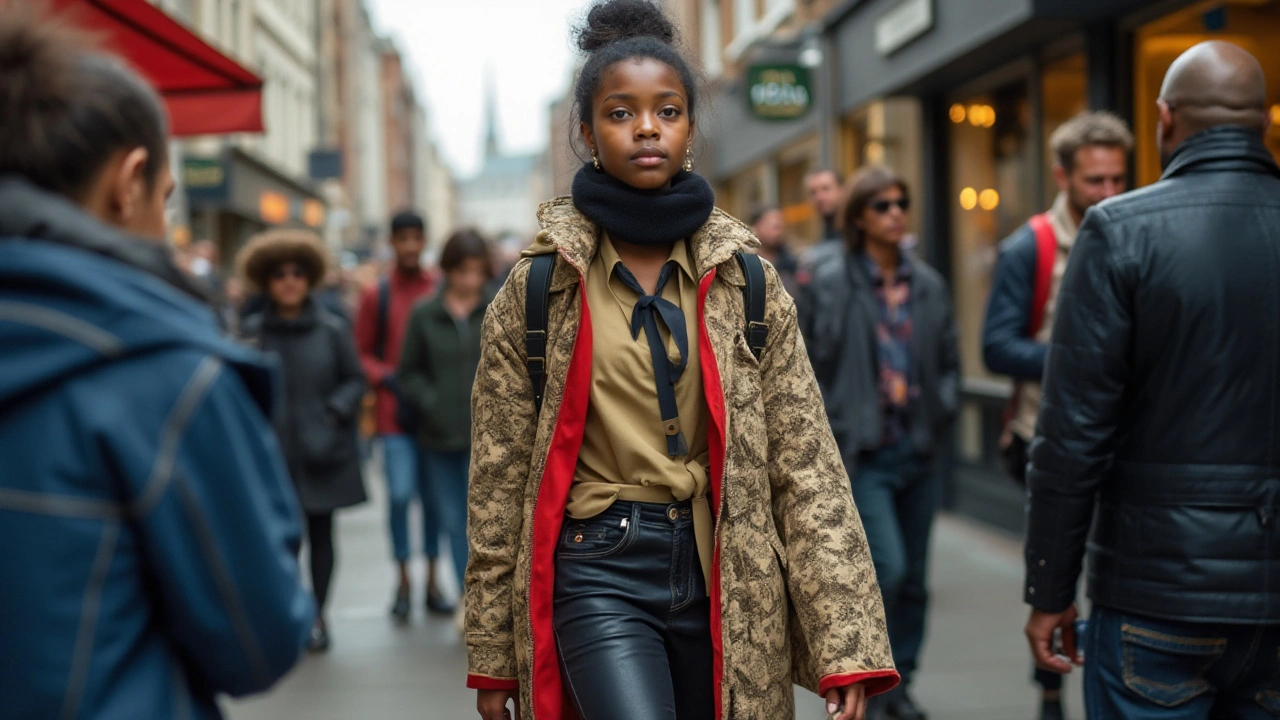Dive into the world of global fashion trends that have been capturing attention and setting runways ablaze. Fashion has always been a melting pot of various cultures and traditions, and today's international styles are no exception.
Driving these trends are unique elements from different parts of the globe, blending into an eclectic yet harmonious mix. Whether it's the vibrant prints of African fabrics, the meticulous embroidery from Asia, or the minimalist European cuts, each has a special place in the modern wardrobe.
- The Rise of Global Fashion
- Key International Style Elements
- Cultural Inspirations in Modern Wardrobe
- Sustainable and Ethical Fashion Choices
- Tips for Incorporating International Trends
The Rise of Global Fashion
In recent years, global fashion trends have become increasingly influential. The fashion industry has opened its doors to cultural exchange, resulting in a fusion of styles that weren't as accessible before. This shift is driven by numerous factors, from technological advances to the growing interest in diverse cultures.
The internet plays a crucial role in this transformation. Social media platforms like Instagram, TikTok, and Pinterest make it easy for fashionistas from different corners of the world to share their unique styles. This global connectivity means that a trend in Tokyo can quickly find its way to Paris, New York, and beyond within days. As a result, designers and brands are more inspired than ever to integrate international styles into their collections.
Another driving force behind this trend is the fashion industry's increased focus on inclusivity and diversity. For a long time, high fashion was dominated by a narrow representation. However, now there's a conscious effort to celebrate all cultures. Designers like Stella McCartney and Virgil Abloh champion diverse voices and draw inspiration from around the globe. This has made the runway more vibrant and eclectic, truly reflecting the world's richness.
Moreover, the idea of blending traditional and modern styles is gaining popularity. African prints, Japanese kimonos, and Indian sarees, among others, are not only seen in their regions of origin but have found a place in mainstream fashion. These elements offer a fresh perspective and add a touch of uniqueness to contemporary clothing. As a result, fashion lovers are now more inclined to experiment with their style, mixing different cultural pieces to create something wholly new.
Economic globalization also contributes to the rise of international styles. As people travel more for both leisure and work, they bring back elements of the cultures they've experienced. This has led to a more eclectic style sensibility that mixes and matches influences from various parts of the world. According to a report by Business of Fashion, global spending on clothing and footwear is projected to grow by over 30% in the next decade, with a significant portion of that growth coming from Asia-Pacific and Africa.
“Fashion is not something that exists in dresses only. Fashion is in the sky, in the street, fashion has to do with ideas, the way we live, what is happening.” - Coco Chanel
Concerns about sustainability and ethical fashion have also shaped this trend. Many international styles champion slow fashion, which emphasizes quality over quantity and promotes traditional methods of clothing production. By adopting these practices, consumers can make more conscious choices while embracing fashion that tells a story and honors its origins.
The rise of global fashion is not just a trend; it signifies a more interconnected and culturally aware world. As people continue to celebrate and share their heritage through fashion, the industry will keep evolving in exciting and inclusive ways. This global approach to style brings about a harmonious blend of respect, creativity, and inspiration, making fashion truly universal.
Key International Style Elements
Diving into the essence of international fashion trends, it's clear that each region offers something unique to the global fashion tapestry. The bold and colorful prints from Africa, such as the vibrant Ankara fabric, have captivated designers worldwide. These prints not only bring a wave of brightness but also carry stories of rich African traditions and cultures. Incorporating these prints into your wardrobe can immediately elevate your style, providing a unique and eye-catching statement.
Meanwhile, Asian countries offer intricate designs and meticulous craftsmanship. Think of the elegant patterns of Japanese kimonos or the finely detailed embroidery of Indian sarees. These elements bring depth and heritage to modern fashion, making them timeless additions to any collection. Renowned fashion designer Oscar de la Renta once said, “Fashion is about dressing according to what’s fashionable. Style is more about being yourself.” It's this blend of authenticity and tradition that makes these styles stand out in the fashion landscape.
European countries, particularly France and Italy, have always been at the forefront of high fashion. Minimalist and chic designs from these regions emphasize a sophisticated and polished look. Classic cuts, tailored fits, and neutral color palettes define European style, providing a touch of elegance and simplicity. These elements remind us that sometimes, less is more, and a well-fitted blazer or a little black dress can go a long way in defining one's wardrobe.
Sustainability has become a crucial part of global fashion trends. Scandinavian countries, known for their pristine landscapes and commitment to the environment, lead the way in sustainable fashion. Brands from this region often focus on eco-friendly materials and practices. By integrating sustainable pieces into your wardrobe, you not only stay trendy but also contribute to a more ethical and eco-conscious fashion industry.
Latin American fashion brings a festive and vibrant spirit to the table. The use of bright colors, flowy fabrics, and traditional patterns from countries like Brazil and Mexico add warmth and joy to any outfit. These styles are perfect for making bold statements and embracing the liveliness of different cultures. Donning a beautifully embroidered Mexican blouse or a colorful Brazilian dress can make everyday wear feel like a celebration.
Finally, let's not forget the Middle Eastern influence in international fashion. Luxurious fabrics such as silk and intricate beadwork are hallmarks of Middle Eastern style. These elements bring a touch of opulence and grandeur, perfect for making an impression at any event. Incorporating such pieces not only diversifies your wardrobe but also reflects a deep appreciation for global artistry.
In summary, embracing international style involves more than just following current trends; it means appreciating the rich tapestry of global cultures. Each region brings something special, from bold African prints to minimalist European cuts, vibrant Latin American colors to intricate Asian craftsmanship. By incorporating these fashion trends into your daily wardrobe, you not only stay ahead in style but also celebrate the incredible diversity that our world has to offer.

Cultural Inspirations in Modern Wardrobe
Culture plays a significant role in shaping fashion trends, and today's global fashion landscape is a testament to this symbiotic relationship. Designers and fashion enthusiasts are constantly seeking inspiration from different parts of the world, blending traditions and modernism. Take, for instance, the vibrant prints often seen in African fashion. These prints, known for their bold colors and intricate patterns, have found a place on the international stage. From high fashion runways to street style, African prints are celebrated for their uniqueness and cultural significance.
Moving over to Asia, one cannot overlook the meticulous attention to detail seen in traditional garments like the kimono from Japan or the cheongsam from China. Modern designers have reimagined these classic pieces, integrating them into contemporary styles. The structured silhouettes and rich fabrics add a touch of elegance and sophistication to any wardrobe. The influence extends beyond just clothing, as accessories like obi belts and embroidered scarves have become trendy additions to modern outfits.
Europe has long been considered the epicenter of fashion, and its impact is undeniable. Italian and French fashion houses continue to set the bar with their minimalist and chic designs. However, there’s a growing trend of incorporating other European cultural elements, such as the intricate lacework from Belgium or the traditional knitwear from Scandinavia. These elements bring a fresh perspective to the classic European aesthetic, making it more diverse and inclusive.
The global fashion industry is also seeing a rise in ethical and sustainable practices, drawing inspiration from indigenous cultures that have long prioritized harmony with nature. Sustainable fashion brands are adopting techniques like natural dyeing and hand-weaving, often sourced from communities in South America and Southeast Asia. This not only promotes environmental responsibility but also supports and honors traditional craftsmanship.
Staying true to the essence of global fashion means celebrating and respecting the cultures that inspire it. As fashion evolves, it becomes a beautiful tapestry of the world's rich heritage. According to fashion expert Julie Gilhart, "Fashion today is not just about looking good; it's about feeling good about the choices we make. Embracing cultural diversity in fashion is a step towards a more inclusive and empathetic world."
Incorporating cultural inspirations into your modern wardrobe can be a simple and joyful process. One practical tip is to start small—add a statement piece that reflects a particular culture, like a Mexican embroidered blouse or a Moroccan kaftan. Pair it with your everyday basics to create a balanced and stylish look. Don’t be afraid to mix and match; after all, fashion is about expressing your individuality.
In summary, cultural inspirations are more than just a passing trend in the fashion world. They are a reminder of the beauty and diversity that exists globally. By embracing international style elements, you not only stay ahead in the fashion game but also contribute to a more inclusive and harmonious world. So, go ahead and explore, experiment, and let your wardrobe reflect the vibrant tapestry of global cultures.
Sustainable and Ethical Fashion Choices
As global fashion trends evolve, there's a growing emphasis on creating a more sustainable and ethical clothing industry. This shift is vital, given the environmental impact of fast fashion and the often exploitative labor practices associated with it. Conscious consumers are now looking for sustainable fashion choices that align with their values, leading to the rise of ethical brands committed to making a difference.
One of the most notable aspects of sustainable fashion is its focus on eco-friendly materials. Organic cotton, recycled fabrics, and biodegradable fibers are not only kinder to the environment but also provide unique textures and qualities to garments. Brands like Patagonia and Stella McCartney are pioneers in this field, showcasing how high-quality fashion can be achieved without harming the planet.
"We believe that sustainability is not just an option, but an imperative," says Stella McCartney, highlighting the importance of adopting responsible practices in fashion.
The ethical side of fashion focuses on fair labor practices. Ensuring workers receive fair wages, operate in safe conditions, and have reasonable working hours, sets ethical brands apart. Companies like People Tree and Everlane are transparent about their supply chains and labor practices, emphasizing the importance of treating workers with respect and dignity.
Another exciting development is the increase in upcycling and reselling of clothes. Platforms such as Depop and ThredUp allow consumers to buy and sell second-hand clothing, reducing waste and giving garments a second life. This circular approach not only minimizes the environmental footprint but also encourages unique, one-of-a-kind fashion finds.
Supporting Local Artisans
Supporting local artisans is a cornerstone of ethical fashion. By purchasing handmade items from local craftspeople, consumers can help sustain traditional skills and techniques that might otherwise disappear. This not only provides a stable income for these artisans but also adds a distinctive, cultural richness to one's wardrobe.
An example is the beautifully embroidered garments from Indian artisans or the intricate beadwork from African communities. These unique pieces tell a story, connecting the wearer to the cultural heritage of the artisans and fostering a greater appreciation for different cultures.
Reducing Carbon Footprint
Another key element of sustainable fashion is reducing the carbon footprint of clothing production. This can be achieved through several methods, such as using renewable energy sources, minimizing waste during the manufacturing process, and opting for local production to cut down on transportation emissions.
| Brand | Initiative |
|---|---|
| Patagonia | Use of recycled materials |
| Levi's | Water-efficient production |
| People Tree | Fair trade practices |
These efforts, combined with the growing awareness and commitment from consumers, have the potential to drive a significant transformation in the fashion industry. By making small, conscious choices, each of us can contribute to a more sustainable and ethical future in fashion.

Tips for Incorporating International Trends
International fashion offers a treasure trove of inspiration for anyone looking to add a bit of global flair to their wardrobe. Whether you're drawn to the intricate weaves of Indian textiles or the sleek lines of Scandinavian design, incorporating international style elements can refresh your look and showcase your worldly taste. Let’s explore some practical tips for integrating these trends into your everyday wear.
Start with accessories if you’re new to international fashion. Accessories like scarves, belts, and jewelry can introduce global elements without overwhelming your outfit. A bright, patterned scarf from Africa can add a pop of color to a monochrome look, while a statement necklace from India can instantly elevate a simple dress. These elements serve as conversation starters and allow you to experiment with different styles without committing fully.
Mix and match different cultures to create a unique blend that reflects your personality. For instance, combine a Japanese kimono-style jacket with a pair of Italian leather shoes. The juxtaposition of styles from different corners of the world can result in a look that’s both eclectic and sophisticated. This approach not only diversifies your wardrobe but also shows off your creativity and understanding of global fashion trends.
Invest in timeless pieces that represent classic elements of international styles. Items like a Chinese silk dress or a French beret can be worn in various ways and remain stylish for years. These pieces often have a rich history and cultural significance, adding depth and meaning to your wardrobe. When choosing such items, look for high-quality materials and timeless designs that transcend seasonal trends.
Don’t forget about ethical fashion. Many international styles come from regions where craftsmanship and traditional techniques are highly valued. Supporting brands that prioritize ethical practices ensures that the artisans are paid fairly and that their cultural heritage is preserved. Ethical fashion not only allows you to wear beautiful clothes but also contributes positively to the global community.
Experiment with textures and fabrics unique to different cultures. The soft, breathable nature of Indian cotton or the luxurious feel of Italian silk can introduce a new dimension to your wardrobe. Different fabrics not only change the aesthetic appeal of your outfits but also offer practicality for various climates and occasions. Pay attention to the care instructions to maintain the longevity of these unique pieces.
Stay updated on global trends by following international fashion weeks and designers. Events like Paris Fashion Week, Tokyo Fashion Week, and Milan Fashion Week are great platforms to see what’s trending around the world. Following designers from different countries on social media can also provide daily inspiration and keep you informed about the latest trends. According to Vogue, “global fashion weeks are the ultimate source for upcoming trends and cultural influences in fashion.”
Lastly, be mindful of cultural appropriation. It’s important to appreciate and respectfully incorporate elements from other cultures. Understanding the history and significance behind a style can enhance your appreciation for it and ensure that you wear it respectfully. Always take the time to research and understand the cultural context of any fashion element you wish to incorporate.
By thoughtfully incorporating international trends, you can diversify your wardrobe and express your love for global fashion. The world is full of rich and varied styles just waiting to be explored, so don’t hesitate to step out of your comfort zone and embrace them.





